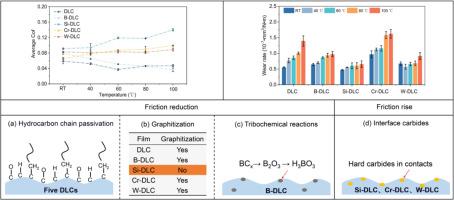油酸润滑下掺杂元素对类金刚石碳膜摩擦学行为及机理的影响
IF 5.1
3区 材料科学
Q2 MATERIALS SCIENCE, COATINGS & FILMS
引用次数: 0
摘要
油酸由于其与类金刚石(DLC)表面独特的相互作用而被公认为是类金刚石膜的优良润滑剂。研究了油酸润滑时掺杂元素对DLC膜摩擦学行为的影响及其机理。采用溅射法制备了掺杂硼、硅、铬和钨的DLC薄膜,并用拉曼光谱、扫描电镜和纳米压痕对其进行了表征。在不同的温度下进行摩擦和磨损试验。B-DLC膜的摩擦系数随温度的升高而减小,Si-DLC和Cr-DLC膜的摩擦系数随温度的升高而增大,W-DLC膜的摩擦系数随温度的升高而减小。Si和W的掺杂提高了DLC薄膜在评估温度下的耐磨性。表面分析表明,油酸分子的摩擦化学吸附主导了DLC膜的摩擦学行为。H3BO3的形成有助于减小B-DLC膜的摩擦磨损。Si-DLC薄膜的石墨化抑制提高了其耐磨性。碳化物成分和石墨化转变共同影响Cr-DLC和W-DLC膜的摩擦磨损,石墨化是一个有利因素。这些发现证明了掺杂剂对DLC-油酸复合体系的明显摩擦学影响,为DLC膜的固液润滑系统提供了新的见解。本文章由计算机程序翻译,如有差异,请以英文原文为准。

Effect of doping elements on the tribological behavior and mechanism of diamond-like carbon film under oleic acid lubrication
Oleic acid is recognized as an excellent lubricant for diamond-like carbon (DLC) films, owing to its unique interaction with DLC surface. This study investigated the influence of doping elements on the tribological behavior and mechanism of DLC films when lubricated with oleic acid. Boron-, silicon-, chromium-, and tungsten-doped DLC films were deposited by sputtering method and characterized by Raman spectroscopy, scanning electron microscopy, and nanoindentation. The friction and wear tests were performed at varying temperatures. Friction coefficients of the B-DLC film decreased with increasing temperature, while the Si-DLC and Cr-DLC films showed increasing friction, and the W-DLC film exhibited minimal temperature dependence. Si and W doping improved the wear resistance of DLC films at evaluated temperatures. Surface analysis revealed that the tribochemical adsorption of oleic acid molecules dominated the tribological behavior of DLC films. The formation of H3BO3 contributed to the reduction in friction and wear of the B-DLC film. The graphitization suppression of the Si-DLC film enhanced its wear resistance. The carbide components and graphitization transition jointly affected the friction and wear of the Cr-DLC and W-DLC films, with graphitization as a beneficial factor. These findings demonstrate the distinct tribological impacts of dopants on the DLC-oleic acid composite system, offering novel insight into the solid-liquid lubrication systems with DLC films.
求助全文
通过发布文献求助,成功后即可免费获取论文全文。
去求助
来源期刊

Diamond and Related Materials
工程技术-材料科学:综合
CiteScore
6.00
自引率
14.60%
发文量
702
审稿时长
2.1 months
期刊介绍:
DRM is a leading international journal that publishes new fundamental and applied research on all forms of diamond, the integration of diamond with other advanced materials and development of technologies exploiting diamond. The synthesis, characterization and processing of single crystal diamond, polycrystalline films, nanodiamond powders and heterostructures with other advanced materials are encouraged topics for technical and review articles. In addition to diamond, the journal publishes manuscripts on the synthesis, characterization and application of other related materials including diamond-like carbons, carbon nanotubes, graphene, and boron and carbon nitrides. Articles are sought on the chemical functionalization of diamond and related materials as well as their use in electrochemistry, energy storage and conversion, chemical and biological sensing, imaging, thermal management, photonic and quantum applications, electron emission and electronic devices.
The International Conference on Diamond and Carbon Materials has evolved into the largest and most well attended forum in the field of diamond, providing a forum to showcase the latest results in the science and technology of diamond and other carbon materials such as carbon nanotubes, graphene, and diamond-like carbon. Run annually in association with Diamond and Related Materials the conference provides junior and established researchers the opportunity to exchange the latest results ranging from fundamental physical and chemical concepts to applied research focusing on the next generation carbon-based devices.
 求助内容:
求助内容: 应助结果提醒方式:
应助结果提醒方式:


